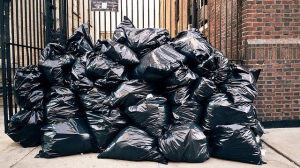New York City’s commercial waste-management system is more broken than anyone realized, according to a report released by Transform Don’t Trash NYC.
The coalition found that New York City businesses produce 5.5 million tons of waste per year—two million more tons than the most recent official estimate. Of those 5.5 million tons, 4 million are “disposed”, sent to the landfill or incinerated, rather than recycled. And while Bloomberg’s 2011 PLaNYC report set the city’s recycling rate by offices, restaurants, stores, hotels, and hospitals at a less-than-great 40%, TDTNYC estimates that the actual percentage is closer to 24%.
If not worse, annual reports foiled with the state’s Department of Environmental Conservation show that last year, two of the biggest private waste haulers in the city recycled just 9% and 13% of their waste, respectively.
TDTNYC obtained these troubling new statistics from a study of commercial waste management in New York City, conducted back in 2012 by Halcrow Engineers, and commissioned by the DSNY.
According to the report thousands of private waste-collecting trucks overlap routes in NYC: in 2012, at least 25 independent trash haulers worked each neighborhood, and a whopping 79 just in Midtown. As a result, the city was faced with unnecessary “pollution, noise, congestion and hazards of excessive truck traffic.”
Setting the 2012 study aside, TDTNYC supplemented these findings with a 2014 survey of 580 businesses across the five boroughs.
Their survey revealed individual blocks in several neighborhoods where collection trucks from 8-10 different hauling companies serviced businesses, and one multi-block commercial strip serviced by 22 different hauling companies. The constant struggle to gain and retain customers leads haulers to operate inefficient routes.
For example, a typical team of two workers operating a truck might collect waste from 70 different restaurants in one night. While a dense customer base would allow these workers to fill their trucks from restaurants in a single neighborhood, in NYC’s open system these workers are likely to drive across multiple neighborhoods and even boroughs to collect the same amount of waste from the same number of restaurants.
“When you’re out there at night, you can be on any particular street and see ten different companies at the same time picking up for different customers. You have haulers coming up all the way from Brooklyn or Queens to the Bronx or Manhattan to collect, and then going all the way back to drop garbage. If you have companies in the Bronx, why does someone from Staten Island have to come to the Bronx to pick up trash,” commented Plinion Cruz, Sanitation Truck Driver for Progressive Waste Solutions.
Cruz has also witnessed considerable shortcomings in the industry when it comes to separating out recycling:
“There are some places where you see that the customer did the diligence and separated the cans in one bag and the cardboard piled separately, and then the solid waste in black bags. The customer takes the time to separate the recyclables, but then the sanitation driver is told to put everything in one truck. So whatever the customer did didn’t serve any purpose because everything is going to be mixed together and when you get to the transfer station, the truck dumps everything and a loader scoops it up to go to a landfill or an incinerator.”
A zoning system confining private waste management companies to geographic areas would at address the traffic issues and cut back on unnecessary gas guzzling but it still does not solve the problem. Businesses are creating too much waste and need the right tools to reduce the volume before finding a more efficient way of disposing of it.
The story was first published on April 20, 2015 here:
http://gothamist.com/2015/04/20/nyc_trashed.php

